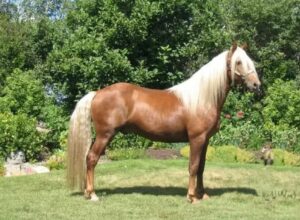
Few horse breeds can compare to the uniqueness of the Tennessee Walking Horse; with its gentle temperament and famously smooth gait, it is a favorite among equestrians and riders of all levels. However, it’s important to delve into the breed’s rich history and heritage to fully appreciate its one-of-a-kind qualities and the joy it brings to those who ride it.
The Tennessee Walking Horse is not just another horse breed; it’s a symbol of Southern culture, a product of careful breeding, and a living testament to the evolution of American equestrian practices.
Early Origins of the Tennessee Walking Horse
The Roots of the Breed
The origins of the Tennessee Walking Horse can be traced back to the late 18th century in the Southern United States. During this time, settlers and farmers in Tennessee and the surrounding regions needed a horse that was not only strong but also comfortable for long rides across rough and varied terrain. They began crossbreeding various horse breeds to meet these needs, including the Narragansett Pacer, Canadian Pacer, Standardbred, Thoroughbred, and Morgan. The result was a new breed that combined the strength and stamina of its ancestors with a smooth, easy-going gait that made it ideal for long-distance travel.
The Role of the Plantation
The Tennessee Walking Horse quickly became a staple on Southern plantations, where it was prized for its versatility and comfort. Plantation owners required a horse that could comfortably carry them across vast expanses of land, often for many consecutive hours. With its unique running walk, this horse breed was perfectly suited for this role. Beyond its utility, the horse became a symbol of status and pride among plantation owners, who often showcased their finest horses at local gatherings and events.
Key Milestones and Figures in the Breed’s Development
The Establishment of the Tennessee Walking Horse Breeders’ Association

As the breed gained popularity, there was a growing need to formalize its standards and promote its unique qualities. In 1935, the Tennessee Walking Horse Breeders’ Association (TWHBEA) was established to play a pivotal role in defining the breed’s characteristics, including its distinctive running walk, and to champion the Tennessee Walking Horse across the United States. The TWHBEA remains a vital institution in preserving the breed’s integrity and heritage, ensuring that the Tennessee Walking Horse endures as a beloved and revered breed for generations to come.
Black Allan (Allan F-1)
Black Allan, also known as Allan F-1, played a significant role in the development of the Tennessee Walking Horse. Born in 1886, he is considered the foundation sire of the breed. While originally intended for trotting, Black Allan’s proficiency in performing a smooth, four-beat gait was pivotal for the breed’s evolution. His genetic influence has endured, with many modern Tennessee Walking Horses tracing their lineage back to him.
The Tennessee Walking Horse in the 20th Century
Popularity and Recognition
The 20th century saw a significant rise in the popularity of the Tennessee Walking Horse, especially during the early to mid-1900s. The breed became a favorite at horse shows and events, where its smooth gait and elegant appearance captivated audiences. The Tennessee Walking Horse National Celebration, a prestigious event that began in 1939, has played a key role in showcasing the best of the breed and promoting its national prominence, a history that all enthusiasts can be proud of.
Preservation and Challenges
Despite its popularity, the Tennessee Walking Horse has faced challenges over the years, particularly related to unethical training practices aimed at enhancing the horse’s gait for competitive purposes. These practices, known as “soring,” have overshadowed the breed’s reputation. However, significant efforts have been made to combat these practices.
The U.S. Congress passed the Horse Protection Act (HPA) in 1970, designed to eliminate soring and protect the welfare of horses in competitions. The HPA made it illegal to show, sell, auction, or exhibit horses subjected to soring and established penalties for violators.
Cultural Impact and Legacy of the Tennessee Walking Horse
The Tennessee Walking Horse in Popular Culture
The Tennessee Walking Horse has made its mark not only in the equestrian world but also in pop culture. The breed has appeared in numerous films, television shows, and books, often symbolizing the American South’s grace, elegance, and charm. Famous Tennessee Walking Horses, such as Trigger Jr., have further cemented the breed’s place in cultural history, showcasing its versatility and appeal to a broad audience.

The Breed’s Influence on Modern Equestrian Practices
The influence of the Tennessee Walking Horse extends beyond its own breed. Its four-beat gait and gentle nature have inspired the development of training techniques and riding practices that prioritize the comfort and well-being of both horse and rider.
The breed’s legacy includes its impact on disciplines such as trail and pleasure riding, where its endurance and smooth gait make it an ideal companion for long, enjoyable rides across diverse terrains.
Experience the Tennessee Walking Horse at Happy Trails
If you’re inspired by the rich history and heritage of the Tennessee Walking Horse, Happy Trails Walking Horses allows you to experience it firsthand! Whether you’re a seasoned rider or new to horseback riding, you can enjoy a memorable ride on one of these magnificent horses. Happy Trails offers an unforgettable beach horseback riding adventure that honors the legacy of the Tennessee Walking Horse.
Book your horseback beach ride on Amelia Island online today!

Leave a Reply